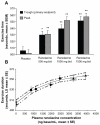Emerging clinical role of ranolazine in the management of angina
- PMID: 21063462
- PMCID: PMC2963161
- DOI: 10.2147/TCRM.S4468
Emerging clinical role of ranolazine in the management of angina
Abstract
Chronic stable angina is an exceedingly prevalent condition with tremendous clinical, social, and financial implications. Traditional medical therapy for angina consists of beta-blockers, calcium channel blockers, and nitrates. These agents decrease myocardial oxygen demand and ischemia by reducing heart rate, lowering blood pressure, and/or optimizing ventricular loading characteristics. Unique in its mechanism of action, ranolazine is the first new antianginal agent approved for use in the US for chronic angina in over 25 years. By inhibiting the late inward sodium current (I(Na)), ranolazine prevents pathologic intracellular calcium accumulation that leads to ischemia, myocardial dysfunction, and electrical instability. Ranolazine has been proven in multiple clinical trials to reduce the symptoms of angina safely and effectively and to improve exercise tolerance in patients with symptomatic coronary heart disease. These benefits occur without reduction in heart rate and blood pressure or increased mortality. Although ranolazine prolongs the QT(c), experimental data indicate that ranolazine may actually be antiarrhythmic. In a large acute coronary syndrome clinical trial, ranolazine reduced the incidence of supraventricular tachycardia, ventricular tachycardia, new-onset atrial fibrillation, and bradycardic events. Additional benefits of ranolazine under investigation include reductions in glycosylated hemoglobin levels and improved left ventricular function. Ranolazine is a proven antianginal medication in patients with symptomatic coronary heart disease, and should be considered as an initial antianginal agent for those with hypotension or bradycardia.
Keywords: antianginal; chronic angina; myocardial ischemia; pharmacotherapy; ranolazine; sodium current.
Figures









Similar articles
-
Effect of ranolazine, an antianginal agent with novel electrophysiological properties, on the incidence of arrhythmias in patients with non ST-segment elevation acute coronary syndrome: results from the Metabolic Efficiency With Ranolazine for Less Ischemia in Non ST-Elevation Acute Coronary Syndrome Thrombolysis in Myocardial Infarction 36 (MERLIN-TIMI 36) randomized controlled trial.Circulation. 2007 Oct 9;116(15):1647-52. doi: 10.1161/CIRCULATIONAHA.107.724880. Epub 2007 Sep 5. Circulation. 2007. PMID: 17804441 Clinical Trial.
-
Ranolazine: effects on ischemic heart.Recent Pat Cardiovasc Drug Discov. 2013 Dec;8(3):197-203. doi: 10.2174/15748901113089990023. Recent Pat Cardiovasc Drug Discov. 2013. PMID: 23961914 Review.
-
Anti-ischemic and pleiotropic effects of ranolazine in chronic coronary syndromes.Am J Med Sci. 2024 Mar;367(3):155-159. doi: 10.1016/j.amjms.2023.12.001. Epub 2023 Dec 9. Am J Med Sci. 2024. PMID: 38072070 Review.
-
Effects of ranolazine with atenolol, amlodipine, or diltiazem on exercise tolerance and angina frequency in patients with severe chronic angina: a randomized controlled trial.JAMA. 2004 Jan 21;291(3):309-16. doi: 10.1001/jama.291.3.309. JAMA. 2004. PMID: 14734593 Clinical Trial.
-
Ranolazine in treatment of stable angina in woman with atrial fibrillation and intermittent left bundle branch block - a case report.Pol Merkur Lekarski. 2016 Dec 22;41(246):287-292. Pol Merkur Lekarski. 2016. PMID: 28024133 Review.
Cited by
-
A Comprehensive Review of Cardiovascular Disease Management: Cardiac Biomarkers, Imaging Modalities, Pharmacotherapy, Surgical Interventions, and Herbal Remedies.Cells. 2024 Sep 1;13(17):1471. doi: 10.3390/cells13171471. Cells. 2024. PMID: 39273041 Free PMC article. Review.
-
Extended-release ranolazine: critical evaluation of its use in stable angina.Vasc Health Risk Manag. 2011;7:535-9. doi: 10.2147/VHRM.S15560. Epub 2011 Aug 25. Vasc Health Risk Manag. 2011. PMID: 21915171 Free PMC article. Review.
-
Do age-associated changes of voltage-gated sodium channel isoforms expressed in the mammalian heart predispose the elderly to atrial fibrillation?World J Cardiol. 2020 Apr 26;12(4):123-135. doi: 10.4330/wjc.v12.i4.123. World J Cardiol. 2020. PMID: 32431783 Free PMC article. Review.
-
Antagonist molecules in the treatment of angina.Expert Opin Pharmacother. 2013 Dec;14(17):2323-42. doi: 10.1517/14656566.2013.834329. Epub 2013 Sep 18. Expert Opin Pharmacother. 2013. PMID: 24047238 Free PMC article. Review.
-
Management of Chronic Total Occlusion of Coronary Artery.Int J Angiol. 2021 Mar;30(1):48-52. doi: 10.1055/s-0040-1721478. Epub 2020 Dec 3. Int J Angiol. 2021. PMID: 34025095 Free PMC article. Review.
References
-
- Brunton TL. On the use of nitrite of amyl in angina pectoris. Lancet. 1867;90:97–98.
-
- Rosamond W, Flegal K, Furie K, et al. Heart disease and stroke statistics 2008 update: A report from the American Heart Association Statistics Committee and Stroke Statistics CommitteeCirculation2008117e25–e146. - PubMed
-
- Boden WE, O’Rourke RA, Teo KK, et al. Optimal medical therapy with or without PCI for stable coronary disease. N Engl J Med. 2007;356:1503–1516. - PubMed
LinkOut - more resources
Full Text Sources
Other Literature Sources

